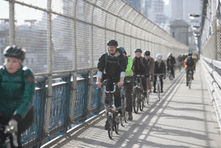New York City sees increase in bike commuters after Hurricane Sandy
Commuters head across the Manhattan Bridge into New York on Nov. 1, 2012, just after Sandy crippled the city’s subway system. (Photo by Andrew Hinderaker.)
The number of cyclists on New York City streets spiked after Superstorm Sandy.
Assaulted by an unprecedented storm surge, many tunnels connecting New York to outer boroughs flooded and choked the city’s public transportation network. And with power out in much of the region, gasoline was hard to find.
But people found ways to gets from here to there. Caroline Sampanaro, director of bicycle advocacy at Transportation Alternatives, said the city saw a huge increase in people trading in the rails for two wheels. She said the number of bike commuters while the subway was recovering tripled from 10,000 daily commuters to 30,000.
“What we have in New York City is a perfect city for bicycling. When you’re talking about transferring trips from cars to bicycle in the city, the vast majority of trips are under five miles, which is a very bike-able distance,” she said.
But, she said, New York still has work to do to make the city more bike friendly, if it wants to sustain bike commuting over the long term. The storm, she said, highlighted how important it is that New York City plan its roads.
“Whether that’s creating HOV lanes, or dedicating lanes to rapid bus service, or making sure that it’s safe to bicycle through dedicated space, these are all really important steps to take to cut emissions and create effective ways to get big groups of people around,” she explained.
But there has been progress over the past five years.
Some 300 miles of bike lanes have been added to the city grid and the city is poised to launch a new bike sharing program — expected to be the largest in the country. The bike sharing program, however, was slowed by Sandy.
“The missing middle is really continuing to build out the grid of protected bike lanes that will encourage people that are scared to ride on city streets with cars, to encourage them to get on their bike and make that two-mile or three-mile trip on their bike,” Sampanaro said.
Of course, there are other problems too. No good, secure bike parking areas, plus who wants to drag a bike up to a fourth of fifth-floor apartment?
“There’s a law in the city that now requires commercial buildings to provide access to bicycles,” Sampanaro pointed out. “(But) there also needs to be some innovations. Maybe there needs to be some secure bike parking at transit, or additional accommodations.”
Sampanaro’s hopeful that Sandy may lead to a permanent increase in bike commuters — even if most of them return to their subways cars.
“Hopefully they’re going to be stuck on the convenience and affordability and practicality of riding a bike to work,” she said. “A storm like this is a wakeup call to really think in a forward-thinking way about how we can make our transportation network last through storms but also be sustainable.”
Every day, reporters and producers at The World are hard at work bringing you human-centered news from across the globe. But we can’t do it without you. We need your support to ensure we can continue this work for another year.
Make a gift today, and you’ll help us unlock a matching gift of $67,000!
